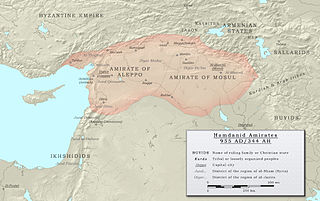Uqaylids of Mosul
Muhammad ibn al-Musayyab died in 996. He was succeeded by his brother al-Muqallad, who in that same year marched on Mosul, forcing its Buwayhid governor to flee. From there the Uqaylids advanced into Iraq; they succeeded in overrunning much of the country and even raiding Baghdad. Eventually the Buwayhid amir Baha' al-Dawla came to terms with al-Muqallad, whereby the Uqaylid was invested by the Abbasid caliph with the rule of Mosul, Kufa and Jami'yan. He was also given the title of "Husam al-Dawla". The treaty made al-Muqallad nominally subservient to the Buwayhids, but in effect he was independent, refusing to pay the tribute that he owed.
Despite the treaty, al-Muqallad still desired to take Baghdad, and might have done so had he not been assassinated by one of his Turkish slaves in 1001. This marked the beginning of the long reign of al-Muqallad's son, Qirwash. In 1002 Qirwash raided Buwayhid territory, prompting Baha' al-Dawla's governor of Baghdad to undertake an expedition against the Uqaylids. Defeated at first, he eventually managed gain a victory over them near Kufa, but at this point was removed from his post as governor, preventing him from following up on this success. In 1005 Qirwash was confirmed in all of his possessions by the caliph, who gave him the title "Mu'tamid al-Dawla".
Qirwash's major problem during the second half of his reign was finding a way to control the Oghuz Turks who were coming in from Iran. The Oghuz even managed to occupy and sack Mosul in 1044, although Qirwash was able to expel them with the support of the Mazyadids. In 1050 Qirwash was removed from power by his brother Baraka ("Za'im al-Dawla"), who reigned until 1052 when he died. Baraka's son Quraysh ("Alam al-Din") succeeded him and ruled for the next nine years. During his reign he acknowledged the supremacy of the Seljuk Empire, although he later came into conflict with them and was temporarily expelled from Mosul. He accompanied the Turk Basasiri when the latter took Baghdad at the end of 1058, but the Seljuks retook the city in the next year.
Quraysh died in 1061 and was followed by his son Muslim ("Sharaf al-Dawla"). Sharaf al-Dawla was a just ruler; the Uqaylid domains were relatively stable for most of his reign. He furthermore gained Aleppo from the Mirdasids in 1080 when its inhabitants offered to hand the city over to him in the hopes that he could protect from Seljuk raids, and he took Harran from the Numayrids in the following year. Soon, however, he ran into trouble with the Seljuks himself. He fought against Sultan Malik Shah's forces and was defeated, but he was pardoned and reinstated. In 1085 he was killed fighting the Seljuks of Süleyman b. Qutulmush. [3] Following Sharaf al-Dawla's death, his brother Ibrahim, who had previously been imprisoned, was released and declared as his successor. Süleyman meanwhile had been killed in the battle of Ain Salm by Tutush, the brother of Malik Shah and ruler of Damascus, and Malik Shah himself took Aleppo in 1086 and appointed Aksungur as governor of the city.
In 1089 or 1090 Ibrahim was summoned to the court of Malik Shah. When he arrived he was imprisoned and was kept close to Malik Shah's side. Mosul during this time was managed by the Seljuk governor Fakhr al-Dawla ibn Jahir. When Malik Shah died in 1092 a fight between Sharaf al-Dawla's sons Ali and Muhammad ensued. Ali was brought by his mother Safiyya to Mosul, but Muhammad attempted to take the city for himself. In a battle at Mosul he was defeated and forced to flee. Ibrahim, meanwhile, had been released by Malik Shah's widow so he returned to Mosul, and eventually convinced Safiyya to give up the city to him.
Ibrahim managed to keep his renewed power for only a short time. The emir of Damascus, Tutush, demanded that he recognize him as sultan in the khutba and allow him passage through his territory. Ibrahim refused, prompting Tutush to move his army against him. The two sides met outside Mosul on 2 April 1093, and in the ensuing battle Ibrahim and his uncle were killed in a bloody battle. Tutush then installed Ali and his mother Safiyya as his representatives in Mosul.
Muhammad b. Sharaf al-Dawla continued to attempt gain Mosul. He recruited the Turkish commander Kerbogha and his brother Tuntash, but Kerbogha imprisoned him. He then attempted to take Mosul from Ali but failed. Kerbogha then executed Muhammad and tried again to take Mosul. As the siege continued, Ali decided to flee to the Mazyadids. Kerbogha eventually gained control of the city in late 1096 and became its amir, ending 'Uqaylid rule there.






